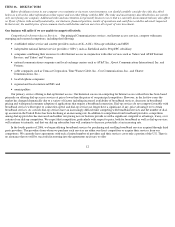Classmates.com 2006 Annual Report Download - page 17
Download and view the complete annual report
Please find page 17 of the 2006 Classmates.com annual report below. You can navigate through the pages in the report by either clicking on the pages listed below, or by using the keyword search tool below to find specific information within the annual report.
percentage is calculated based on the average number of pay accounts for a period. The average number of pay accounts is a simple average
calculated based on the number of pay accounts at the beginning and end of a period. We make certain normalizing adjustments to the
calculation of our churn percentage for periods in which we add a significant number of pay accounts due to acquisitions. We do not include in
our churn calculation those accounts cancelled during the first thirty days of service unless the accounts have upgraded from free accounts,
although a number of such accounts will be included in our account totals at any given measurement date. Subscribers who cancel one pay
service but subscribe to another pay service are not considered to have cancelled a pay account and, as such, our overall churn rate is not
necessarily indicative of the percentage of subscribers canceling any particular service. We have experienced, and will likely continue to
experience, a higher percentage of subscribers canceling our accelerated access and social-networking services than is indicated by our churn
rate, and the percentage of subscribers canceling our social-networking services has fluctuated significantly from quarter to quarter due to
seasonality and the timing of termination of multi-month programs. Our churn may be higher in future periods and will fluctuate from period to
period and from service to service. If we continue to experience a high percentage of pay accounts canceling our services, it will make it more
difficult to grow, maintain or minimize decreases in the number of pay accounts for those services. If we experience an increased percentage of
cancellations, our revenues and profitability may be adversely affected.
Each month, a significant number of free accounts become inactive and we may experience continued declines in the number of active free
accounts. In addition, a user may have more than one account on more than one of our services, and we are not able to determine in most cases
the number of accounts held by an individual. As such, the actual number of unique individuals using our services may be much lower than our
total number of accounts.
We may be unsuccessful at acquiring additional businesses, product lines or technologies. Even if we complete an acquisition, it may not
improve our results of operations and may adversely impact our business and financial condition.
One of our strategic objectives is to acquire businesses, product lines or technologies that will provide us with an opportunity to leverage
our assets and core competencies, or that otherwise will be complementary to our existing businesses. We may not succeed in growing or
maintaining our revenues unless we are able to successfully complete acquisitions. The merger and acquisition market for companies offering
Internet services is extremely competitive, particularly for companies who have demonstrated a profitable business model with long-
term growth
potential. Companies with these characteristics trade publicly or are privately valued at multiples of earnings, revenues, operating income and
other metrics significantly higher than the multiples at which we are currently valued. Acquisitions may require us to obtain additional debt or
equity financing, which may not be available to us on reasonable terms, or at all. These and other factors may make it difficult for us to acquire
additional businesses, product lines or technologies at affordable prices, or at all, and there is no assurance that we will be successful in
completing additional acquisitions.
We routinely engage in discussions regarding potential acquisitions and any of these transactions could be material to our financial
condition and results of operations. However, we cannot assure you that the anticipated benefits of an acquisition will materialize or that any
integration attempts will be successful. Acquiring a business, product line or technology involves many risks, including:
•
disruption of our ongoing business and diversion of resources and management time;
•
unforeseen obligations or liabilities;
•
difficulty assimilating the acquired customer bases, technologies and operations;
•
difficulty assimilating and retaining employees from the acquired business;
16
























